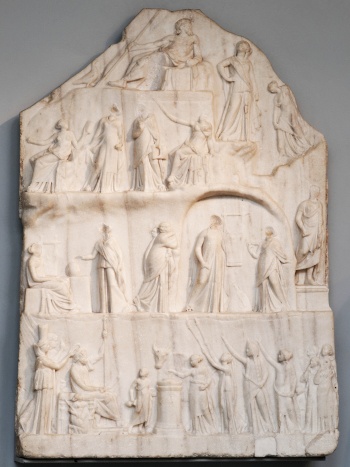Archelaus Relief or Apotheosis of Homer
Image: London, British Museum, inv. 1819,0812.1.
Object description: A marble relief signed by Archelaus of Priene, shows a mythical scene over four registers. The lowest register shows an architectural space defined by columns that support drapery. Within this space Chronos (Time) and Oikumene (the Inhabited World) crown an enthroned Homer who holds a sceptre and a scroll. Kneeling on either side of the poet are personifications of the Iliad and Odyssey. To the right of this register personifications of various genres of literature guide a bull to sacrifice on an altar before the poet, and lift up hands and torches in worship. The middle two registers are thought to depict the slopes of mount Helicon. In these registers are shown the nine Muses, and possibly Apollo playing a lyre in a cave (Pinkwart 1965: 78-82). The upper register portrays a reclining Zeus exchanging looks with Mnemosyne (Memory). Half way down the relief on the right a separate, standing figure is presented on a small plinth. This has been thought to represent a poet victorious in a competition, for the commemoration of which this relief was commissioned (Pinkwart 1965: 85-6). The date of this object’s production is debated: opinions range from the late third century (Richter 1965: 54), to the late second century (Pinkwart 1965: 48-63).
Object archaeology: Found in the mid-seventeenth century on the Appian Way near Bovillae (Richter 1965).
Inscriptions: The names of many of the figures are inscribed in Greek. For transcription see Newton, Hicks et al. 1874, no. 1098.
Restorations: Several restorations took place in the seventeenth century (Elderkin 1936), including the heads that have since been removed, but which are still visible on some casts (for example that in Cornell University’s Goldwin Smith Hall, NY).
Dimensions: height 121cm, width 76cm
Bibliography
- Boehringer, R. B. and Boehringer, E. 1939. Homer Bildnisse und Nachweise. Breslau.
- Clay, D. 2004. Archilochos Heros : The Cult of Poets in the Greek Polis. Cambridge, Mass. 58, 88.
- Newby, Z. 2007. ‘Reading the Archelaos Relief.’ In Z. Newby and R. Leader-Newby eds., Art and Inscriptions in the Ancient World. Cambridge. 156-178.
- Newton, C. T., Hicks, E. L., Hirschfeld, G. and Marshall, F. H. 1874. The Collection of Ancient Greek Inscriptions in the British Museum. Oxford.
- Pinkwart, D. 1965. Das Relief des Archelaos von Priene und die “Musen des Philiskos”. Kallmünz. 19-90.
- Richter, G. M. A. 1965. The Portraits of the Greeks, vol. 1. London. 54.
- Richter, G. M. A. and Smith, R. R. R. 1984. The Portraits of the Greeks.
- Schefold, K. and Bayard, A.-C. 1997. Die Bildnisse der Antiken Dichter, Redner und Denker. Basel. 336-37.
- Zanker, P. 1995. The Mask of Socrates : The Image of the Intellectual in Antiquity (Shapiro, A., trans.). Berkeley. 159-62.
| Relevant guides | Homer: A Guide to Sculptural Types |
|---|

